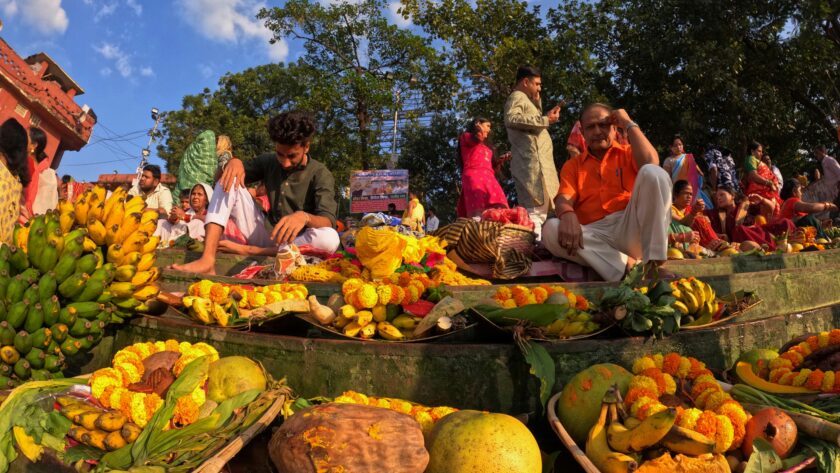Chhath Puja Celebration stands as an ancient Hindu festival that captivates participants primarily in the Indian states of Bihar, Jharkhand, Uttar Pradesh, and the Madhesh region of Nepal. This festival honors the Sun God, Surya, and his wife, Usha. Unlike many other Hindu festivals that involve elaborate rituals and decorations, Chhath Puja emphasizes simplicity, devotion, and gratitude toward nature and its elements. As we explore the intricacies of Chhath Puja Celebration, we will delve into its significance, rituals, health benefits, cultural importance, environmental awareness, and the unity it fosters among communities.
The Significance of Chhath Puja
Chhath Puja typically takes place in October or November, lasting for four days. This festival holds deep significance, steeped in mythology and meaning. Worshiping Surya dates back to the Vedic period, where ancient texts depict him as a source of light, energy, health, and prosperity. By honoring the Sun, devotees express gratitude for the life-giving force that sustains all living beings on Earth.
Women, in particular find significance in this festival as they pray for their families’ well-being and the long life of their husbands. The festival symbolizes harmony between humanity and nature, reminding participants of their responsibility to protect and nurture the environment.
Mythological Roots
The origins of Chhath Puja trace back to various mythological stories. One popular narrative comes from the epic Mahabharata. According to this tale, Kunti, the mother of the Pandavas, invoked Surya to grant her a boon, resulting in the birth of her first son, Karna. Grateful for Surya’s blessings, Kunti and her sons continued to honor him through rituals. This story highlights the importance of familial bonds and the connection between humans and the divine.
The Rituals of Chhath Puja
The rituals of Chhath Puja celebration stand out for their uniqueness and rigor, showcasing the deep devotion of participants. The festival consists of four main days, each with specific customs and practices.
Day 1: Nahay Khay
Nahay Khay marks the beginning of Chhath Puja. The day starts with devotees taking a holy dip in a river or any clean water body. This act of purification symbolizes cleansing the body and soul in preparation for the upcoming rituals. After bathing, the devotees prepare a special meal, which typically includes rice, lentils, and seasonal vegetables. They cook this food in earthen pots, enhancing its traditional flavor and connecting the offering to nature.
Participants offer the food prepared on this day to their family deities and consume it afterward. Nahay Khay emphasizes purity, both physically and spiritually. Devotees cleanse themselves of physical impurities and negative energies, preparing for a deeper spiritual experience.
Day 2: Kharna
The second day of Chhath Puja, called Kharna, involves a day-long fast, which devotees break only after sunset. Participants observe the fast with strict discipline, refraining from consuming food or water during the day. In the evening, they prepare a special meal, primarily consisting of kheer (a rice pudding made from rice, milk, and jaggery), and offer it to the Sun God as gratitude for his blessings.
Kharna symbolizes the completion of the first phase of fasting, strengthening the bond between the devotee and the divine. After breaking their fast, participants engage in prayers and rituals, seeking blessings for the health and prosperity of their families. The day emphasizes self-control, devotion, and gratitude.
Day 3: Sandhya Arghya
The third day, known as Sandhya Arghya, represents the festival’s most significant day. Devotees gather near water bodies—rivers, lakes, or ponds—during sunset to offer prayers to Surya. They prepare offerings, including sugarcane, fruits, and thekua (a traditional sweet made from wheat flour and jaggery), placing them in bamboo baskets called “soop.”
With great reverence, devotees stand in water while performing the Arghya ritual. They raise their hands toward the setting sun, singing traditional folk songs and hymns that praise the Sun God. Offering Arghya becomes a profound expression of gratitude and devotion, emphasizing the importance of community and the shared experience of worship.
Day 4: Usha Arghya
The final day of Chhath Puja, called Usha Arghya, sees devotees gather again at dawn to offer prayers to the rising sun. This day marks the festival’s conclusion and features similar rituals to those performed on the previous day but at sunrise. Participants prepare the same offerings to emphasize continuity and consistency in devotion.
After the prayers, they distribute the offerings among family and friends, symbolizing unity and the spirit of sharing. The conclusion of Chhath Puja reinforces the themes of gratitude and community, reminding devotees of their interconnectedness with one another and with nature.

Health Benefits of Fasting During Chhath
Fasting serves as a central aspect of Chhath Puja, offering various health benefits. Participants typically consume light and nutritious foods during the festival. By abstaining from heavy meals and focusing on wholesome foods like fruits, grains, and lentils, devotees often experience detoxification, improved digestion, and enhanced metabolic health.
Detoxification and Cleansing
Fasting allows the body to detoxify and cleanse itself. Abstaining from processed foods and focusing on natural ingredients helps eliminate toxins and can lead to improved overall health. The light meals consumed during the festival provide essential nutrients while allowing the digestive system to rest.
Mindfulness and Spiritual Reflection
Fasting encourages mindfulness and spiritual reflection. Devotees engage in self-discipline and reflection during the fasting period, promoting mental clarity and emotional stability. This time of introspection allows individuals to connect with their spiritual beliefs, fostering a deeper understanding of their faith.
Nutritional Benefits
The meals prepared during Chhath Puja typically contain essential nutrients. Ingredients like jaggery, lentils, and seasonal fruits provide vitamins, minerals, and antioxidants that contribute to overall health. For example, jaggery acts as a natural sweetener, aids digestion, and is rich in iron, while lentils offer a great source of protein and fiber. The emphasis on natural foods during this festival contributes to physical well-being and supports a balanced diet.
Cultural Significance and Community Bonding
Chhath Puja goes beyond religious observance; it celebrates culture, tradition, and community. The festival features vibrant celebrations, traditional music, and communal feasting. Families come together to prepare for the rituals, sharing experiences and stories that strengthen familial ties and community connections.
Celebrations and Festivities
In the days leading up to Chhath Puja, markets bustle with activity as people shop for traditional items needed for the rituals. Colorful decorations adorn homes, and local communities organize events to celebrate the festival. Enthusiasm and joy fill the atmosphere as participants prepare for the rituals.
Traditional Music and Dance
Music plays a vital role in Chhath Puja celebrations. Devotional songs, known as “Chhath Geet,” fill the air during rituals, and traditional dances often accompany these songs. These performances foster community and create a sense of belonging. The celebration of music and dance reflects the festival’s cultural richness, enhancing unity among participants.
Community Involvement
Chhath Puja serves as a communal festival that encourages participation from all members of society, regardless of caste or creed. The shared experience of preparing for the festival, participating in rituals, and celebrating together strengthens community bonds. This inclusivity promotes harmony and understanding among diverse groups, highlighting the festival’s essence of unity.
Challenges and Environmental Awareness
While Chhath Puja celebrates nature, it also poses environmental challenges, particularly concerning waste management. The increased activity near water bodies often leads to pollution and degradation of these natural resources. Therefore, participants should engage in sustainable practices, ensuring respect and protection for the environment.
Pollution Concerns
The rituals of Chhath Puja celebration can contribute to water pollution due to the offerings made, such as flowers, fruits, and plastic items. To address these concerns, devotees should adopt environmentally friendly practices, such as using biodegradable offerings and minimizing plastic use. Many communities initiate campaigns to raise awareness about the importance of protecting water bodies during the festival.
Sustainable Practices
Devotees need to practice sustainability during Chhath Puja. This includes cleaning up after rituals, properly disposing of waste, and avoiding non-biodegradable materials. Some communities organize cleanup drives along rivers and water bodies to promote environmental stewardship and raise awareness about the need to protect these natural resources.
Promoting Environmental Stewardship
Chhath Puja provides an opportunity to promote environmental stewardship among participants. By emphasizing the importance of protecting nature and its resources, devotees can connect the spiritual aspects of the festival with real-world environmental challenges. This integration of spirituality and environmental consciousness can inspire individuals to adopt more sustainable practices in their daily lives.

Connecting Faith and Responsibility
This festival connects our spiritual practices with our responsibility to take care of the Earth. Chhath Puja celebration changes from just a religious observance into a joyful celebration of life, health, and unity. As we offer our prayers and thank the Sun God, we also recognize our shared duty to protect the environment and support our communities.
For more insights and stories about festivals and traditions, visit our blog https://ucalorie.com/category/blog/ for a deeper understanding of cultural celebrations.



